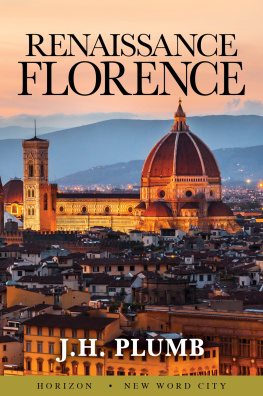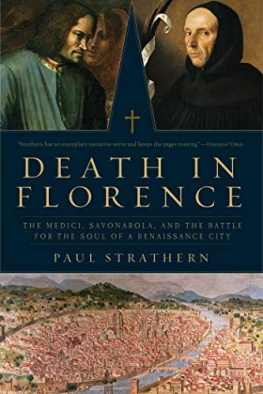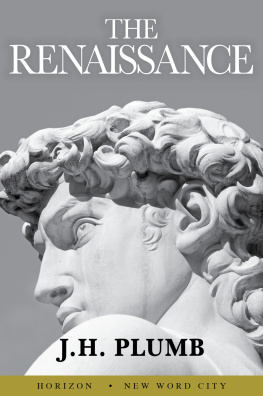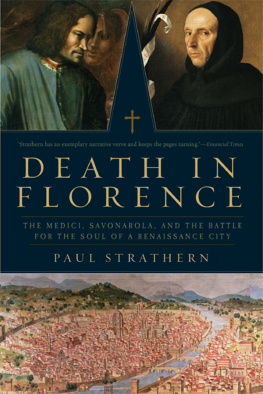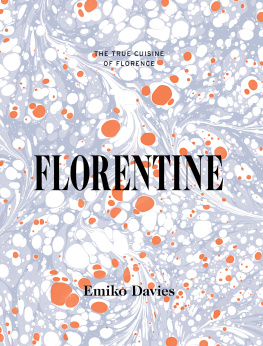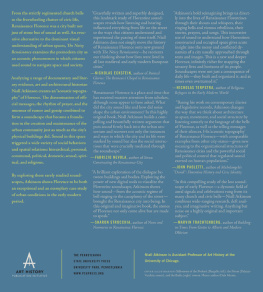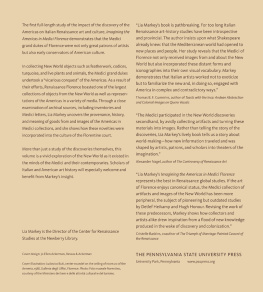J.H. Plumb - Renaissance Florence
Here you can read online J.H. Plumb - Renaissance Florence full text of the book (entire story) in english for free. Download pdf and epub, get meaning, cover and reviews about this ebook. year: 2015, publisher: New Word City, Inc., genre: Detective and thriller. Description of the work, (preface) as well as reviews are available. Best literature library LitArk.com created for fans of good reading and offers a wide selection of genres:
Romance novel
Science fiction
Adventure
Detective
Science
History
Home and family
Prose
Art
Politics
Computer
Non-fiction
Religion
Business
Children
Humor
Choose a favorite category and find really read worthwhile books. Enjoy immersion in the world of imagination, feel the emotions of the characters or learn something new for yourself, make an fascinating discovery.
- Book:Renaissance Florence
- Author:
- Publisher:New Word City, Inc.
- Genre:
- Year:2015
- Rating:5 / 5
- Favourites:Add to favourites
- Your mark:
- 100
- 1
- 2
- 3
- 4
- 5
Renaissance Florence: summary, description and annotation
We offer to read an annotation, description, summary or preface (depends on what the author of the book "Renaissance Florence" wrote himself). If you haven't found the necessary information about the book — write in the comments, we will try to find it.
Of all the Italian cities, Florence was the cradle of the Renaissance. But Florentine life was brutal, not gentle. However wealthy and beautiful it appeared, economically and strategically, its position was always desperate. Despite its perils, the families and artists of Florence flourished. Here, from eminent British historian Sir J. H. Plumb, is the story of Renaissance Florence - from the Medici and the Pazzi to Michelangelo and Leonardo.
Renaissance Florence — read online for free the complete book (whole text) full work
Below is the text of the book, divided by pages. System saving the place of the last page read, allows you to conveniently read the book "Renaissance Florence" online for free, without having to search again every time where you left off. Put a bookmark, and you can go to the page where you finished reading at any time.
Font size:
Interval:
Bookmark:
In a few hours they were burnt, their legs and arms gradually dropping off; part of their bodies remaining hanging to the chains, a quantity of stones were thrown to make them fall, as there was a fear of the people getting hold of them; and then the hangman and those whose business it was, hacked down the post and burnt it on the ground, bringing a lot of brushwood, and stirring the fire up over the dead bodies, so that the very least piece was consumed. Then they fetched carts, and accompanied by the mace-bearers, carried the last bit of dust to the Arno, by the Ponte Vecchio, in order that no remains should be found.
So wrote the diarist Luca Landucci after watching the execution of Girolamo Savonarola and his disciples. So ended the life of the strange, doom-haunted Dominican monk from Ferrara, whose bitter tirades against luxury, greed, extortion, and tyranny had torn Florentine society apart.
The Piazza in which Savonarola met his end was adorned with some of the most profoundly moving works of Renaissance art. He had given the apocalyptic sermons for which he was condemned under the vaulting dome of the cathedral, a triumph of the new architecture. In his audience had sat the flower of Italian humanism - Pico della Mirandola, Angelo Poliziano, and Marsilio Ficino, the president of the Platonic Academy - and he told them roughly that an old woman knew more of faith than their Plato. Even Lorenzo de Medici, the greatest of all Florentine patrons, had sought his friendship, only to be spurned. Savonarola rejected the Renaissance. He would have none of it, ignoring the fact that for 100 years Florence had led Italy in painting, sculpture, philosophy, and sophistication. Of all Italian cities, Florence had been the cradle of the Renaissance, but curiously, except in its earliest days, the spirit of Savonarola had always been abroad. Florence was a city of violent contrasts, a city of the light and the dark.
Physically, Florence deceives: The golden Tuscan landscape, rich, fertile, gentle in climate, suggests a pastoral, idyllic life in harmony with nature. Here is a countryside made for a Giorgione or a Titian, yet Florence produced neither, nor indeed any painter who sought to immortalize the poetry of nature. Florentine life was brutal, not gentle. However rich and beautiful its situation might be, economically and strategically its position was always desperate. To the west, controlling its only outlet to the sea, lay prosperous and powerful Pisa, linked by its commerce with the four corners of the Mediterranean world. Across the route to Pisa, Florence had an unbeatable enemy in Lucca. To the north stood Milan, ravenous for land and rich in men and money. To the south, almost on Florences doorstep, Siena controlled the road to Rome, and the Sienese were as fiercely proud and warlike as the Florentines. To the east were the wolves, the ravagers, the petty tyrants of the Papal Patrimony who lived by war and violence; for these despots, the rich lands of Tuscany were sweet to plunder. To survive, let alone expand, Florence required from its citizens both courage and resourcefulness, a willingness to practice diplomacy as well as war. Both required money, and in the end, wealth alone enabled Florence to survive and to triumph over the disadvantages of its geographical situation. The realities of Florentine life were the sword and the florin. The use of both was improved by skill in reading human nature, and it is not surprising that a preoccupation with destiny lies at the heart of the Florentine Renaissance.
Despite its perils, Florence triumphed. The prime source of its strength and wealth lay in its arti, the guilds that united its merchants and skilled craftsmen. One of the earliest to be organized was the arte di Calimala, and it held its dominating position throughout the golden age of Florence. The Calimala was a guild of merchants who brought undressed cloths from England, Flanders, and France to Florence, where they were reworked into fine materials and dyed in the splendid, vivid colors that Renaissance painters have made so memorable - the blues and crimsons and reds in which they dressed their saints and Madonnas. They exported the finished goods throughout Europe, and the stamp of the guild became a guarantee of worth and workmanship. The guild, which became a model for others that would dominate Florence in the late twelfth and thirteenth centuries, was meticulously ruled and its members subjected to strict discipline, both in their public and moral lives. Including the Calimala, there were seven guilds - the wool merchants, silk weavers, bankers, notaries, druggists (members of this guild also dealt in spices and precious stones), and furriers. These seven included all the great merchants of Florence, who formed the heart of its economic life. But Florence was a large town, with many influential shopkeepers who formed their own guilds, known as the lesser arts - the innkeepers, shoemakers, carpenters, blacksmiths, grocers, bakers, and the like - fourteen in all. Each guild had consuls, notaries, and a banner-bearer, as well as a church in which it held its special masses, for these merchants were deeply steeped in religion. (At the head of each page of one of their surviving account books is the sign of the cross, made to make forgery hell-worthy.) The Florentine guilds were small worlds unto themselves, closely regulated, self-conscious, jealous of their rights and customs, and fully aware of their power.
Relations between the greater and lesser guilds were often uneasy. The lesser guilds felt their numbers gave them a right to power; the greater knew that their money sustained the government of Florence both in peace and in war. Yet there were never more than 3,000 or 4,000 men in these twenty-one guilds, and Florence had a population of nearly 100,000. Most people worked for a day wage - spinning, dyeing, weaving, carding, or hauling the great bales of wool and cloth and silk the people who had fought for the liberties within the city and for its rich territories and within whose hearts Savonarolas words burned like fire. They were organized into four districts, each with four quarters led by a banner under which each citizen was enrolled to fight, if necessary, for the city. From these quarters, the governors of the city, who made up the Signory, or council, that ruled Florence, were selected; they made peace or war and levied taxes. Naturally, the Signory was highly ceremonial and its chief officers, the priors, lived in luxury, but their tenure was brief, for they ruled for only two months. To control this complex governmental machine, men fought in the streets, assassinated, exiled, pillaged, and destroyed each other generation after generation, so that one Florentine gloomily remarked there were enough citizens in exile to populate another city. The main strife revolved around who was worthy to be prior - whether power should be widely distributed or kept close - and whether the major arts or the minor arts should dominate the government. There was strife not only within the ranks of the guilds but among the restless public, often swayed by hunger due to the economic storms of uncontrolled capitalism. Over the centuries, power in Florence drifted into the hands of oligarchs only to be snatched out, but never for long.
During most of the Renaissance, political power in Florence was in the hands of a group of wealthy merchants, led by the Medici family. This closely knit oligarchy controlled all the elections, and more importantly, they handled the citys taxes. They were also the inheritors of vast wealth from the four quarters of Europe.
Suspicious and guarded, these merchants clung tenaciously to their power, willing to serve the Medici only as long as the Medici served them. Their greed and envy occasionally brought them close to conspiracy, and the Pazzi familys plot to kill two Medici sons in the Duomo was considered treasonous. Politically and financially these men had little foresight: They exploited their power to siphon the citys riches into their own pockets. Yet they had one saving grace: They had been born into a tradition of civic patronage. Their fathers, and their fathers before them, had endowed monasteries, beautified churches, and established charities. Because a sense of sin still clung to usury and to the bankers trade, they felt the need to return a tithe on their profits. Naturally, they were encouraged by particular acts of Gods goodness, and their piety turned quickly into patronage. But around 1400, this tradition began to change.
Next pageFont size:
Interval:
Bookmark:
Similar books «Renaissance Florence»
Look at similar books to Renaissance Florence. We have selected literature similar in name and meaning in the hope of providing readers with more options to find new, interesting, not yet read works.
Discussion, reviews of the book Renaissance Florence and just readers' own opinions. Leave your comments, write what you think about the work, its meaning or the main characters. Specify what exactly you liked and what you didn't like, and why you think so.

